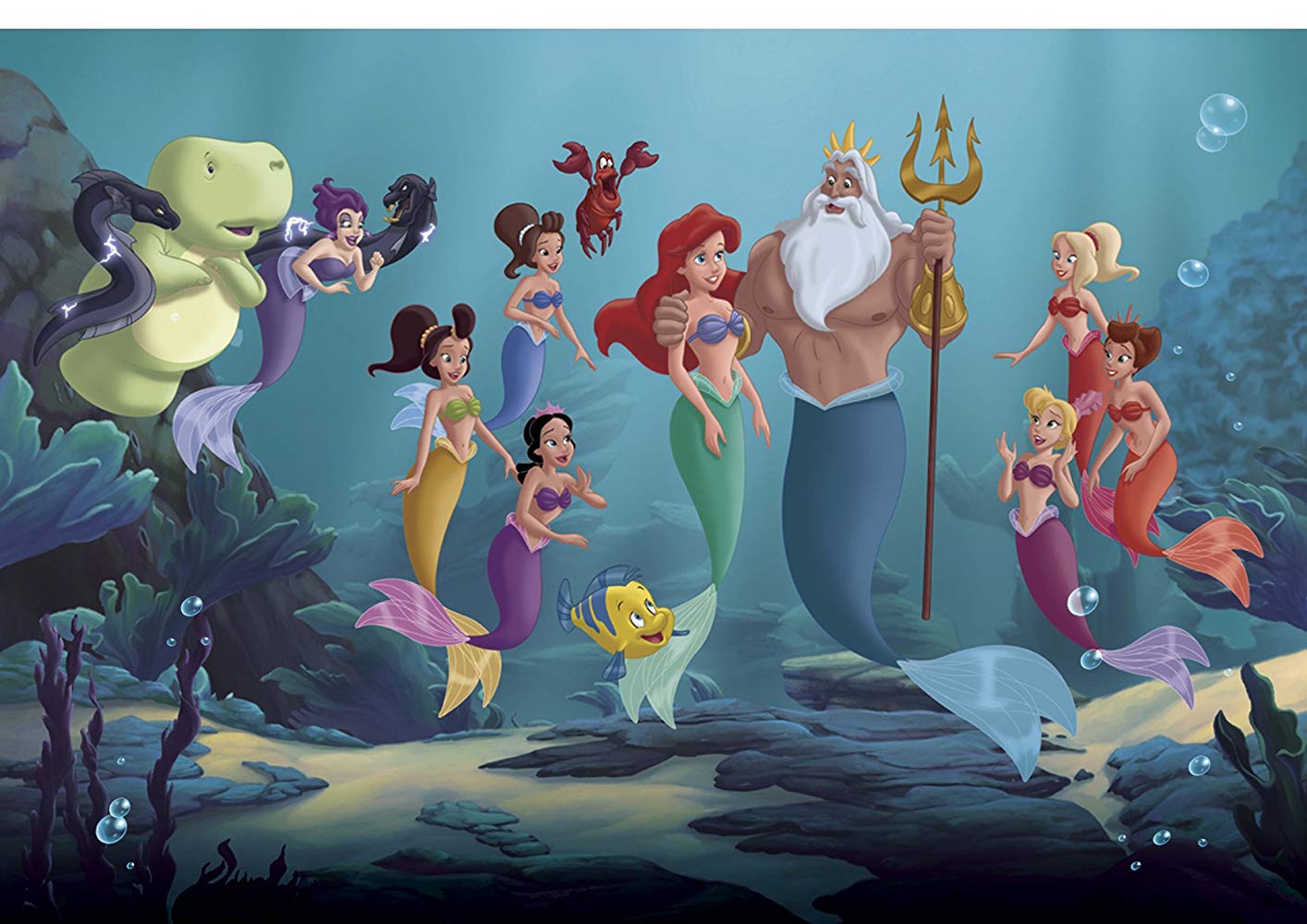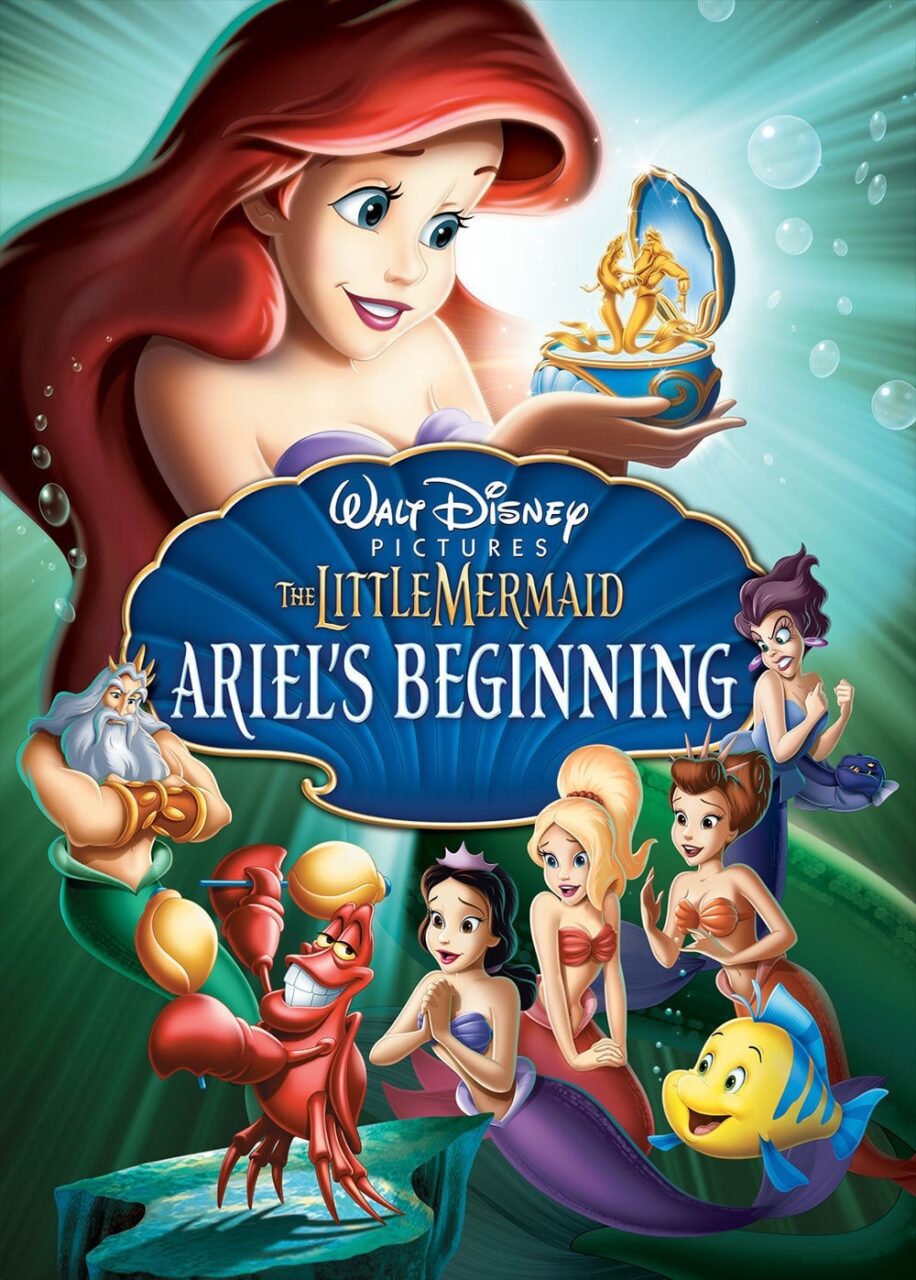Crew
Director – Peggy Holmes, Screenplay – Robert Reece & Evan Spiliotopoulos, Story – Jule Selbo & Jenny Wingfield, Producer – Kendra Haaland, Music – James Dooley, Songs – Jeanine Tesori, Animation – Toon City Animation, Inc. (Supervisors – Bienifer Mores & Rolando Sobado), Art Direction – Tony Pulham. Production Company – Disney Toon Studios.
Voices
Jodi Benson (Ariel), Samuel E. Wright (Sebastian), Sally Field (Marina Del Ray), Jim Cummings (King Triton/Shelbow), Parker Goris (Flounder), Tara Strong (Adella/Andrina), Jennifer Hale (Alana), Grey Delisle (Aquato/Arista), Kari Wahlgren (Attina), Jeff Bennett (Benjamin), Kevin Michael Richardson (Cheeks/Ray-Ray), Rob Paulsen (Ink Spot/Swifty), Lorelei Hill Butters (Queen Athena)
Plot
Growing up as a child in Atlantica, Ariel is happy in the constant fun she has with her father King Triton and six sisters. One day they are all on the surface where Triton presents his wife Athena with a music box. However, a sailing ship comes and Athena is killed as she tries to prevent it crashing onto the rocks. Immediately after, Triton falls into a slump and passes a decree that forbids any music be played in the kingdom. As she grows up, Ariel befriends the young fish Flounder and is party as he is nearly arrested for making music by tapping on barnacles. Curious, Ariel follows Flounder and is startled to discover the Catfish Club, a venue where the various denizens of Atlantica secretly make music and the lead singer in a conga group is none other than the royal chamberlain, the crab Sebastian. Ariel then brings her sisters down to visit the club. However, the scheming royal nanny Marina Del Ray follows and has all of them arrested. With Sebastian disgraced, Marina takes over the chamberlain’s job and immediately relishes the power. The princesses are banished to their quarters but Ariel sneaks out and springs the other musicians from jail. Sebastian leads them away from Atlantica to find somewhere where they can play music in freedom. However, Marina has unleashed her trained electric eels to hunt and kill them all.
Starting in the 1990s, Disney created a fad churning out numerous cheap and almost always inferior direct-to-video/dvd sequels to their animated classics. These have included The Return of Jafar (1994), Aladdin and the King of Thieves (1996), Beauty and the Beast: The Enchanted Christmas (1997), Pocahontas II: Journey to the New World (1998), The Lion King II: Simba’s Pride (1998), Fantasia 2000 (1999), Lady and the Tramp II: Scamp’s Adventure (2001), Cinderella II: Dreams Come True (2002), The Hunchback of Notre Dame II (2002), Return to Never Land (2002), Atlantis: Milo’s Return (2003), The Jungle Book 2 (2003), 101 Dalmatians II: Patch’s London Adventure (2003), Stitch! The Movie (2003), Mulan II (2004), The Emperor’s New Groove 2: Kronk’s New Groove (2005), Lilo & Stitch II: Stitch Has a Glitch (2005), Tarzan 2 (2005), Bambi II (2006), Brother Bear II (2006), The Fox & the Hound 2 (2006), Leroy & Stitch (2006), Cinderella III: A Twist in Time (2007) and TinkerBell (2008). Amid these, The Little Mermaid (1989) was previously sequelised as The Little Mermaid II: Return to the Sea (2000), as well spun off as the tv series The Little Mermaid (1992-4).
The Little Mermaid: Ariel’s Beginning sets out to be a Little Mermaid origin story. The question that must surely be asked is – in the great scope of the history of Western culture, amid all the great artworks that exist out there, was the world burning to see a Little Mermaid origin story? Amid all the unseen and undiscovered classics that this reviewer has yet to see, is his time best spent watching and writing up The Little Mermaid: Ariel’s Beginning? Well, here I am, so I guess the answer is apparently no.

Like most of the other aforementioned sequels to their classics, The Little Mermaid: Ariel’s Beginning is cheaply produced and coasts by on the sense that audiences loved the original. Ariel’s Beginning is at least lively and colourful enough that it never sinks like some of the other Disney direct-to-video sequels do. There are banal songs added over everything – indeed, the entire film could almost be a feature-length expansion of the musical frolics of the first film (albeit minus the romance/fairytale aspects). This is not too surprising in that director Peggy Holmes was previously a dancer and dance choreographer.
Jodi Benson and Samuel E. Wright return to respectively voice Ariel and Sebastian, as they did in the two previous films and the tv series. This time we are introduced to several new characters. We meet Ariel’s sisters who are played as though they are all giggly teenage airheads. The surprise name among the cast is none other than Sally Field, who provides the voice of the villainess of the show. Even though Field rises grandly to the occasion, Marina is still a stock character cast too much in the shadow of the first film’s villainess Ursula.
Peggy Holmes made her debut as director here and subsequently went on make the TinkerBell films Secret of the Wings (2012) and The Pirate Fairy (2014). Holmes later went on to direct Skydance’s debut theatrical animated film Luck (2022).
Trailer here


